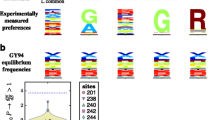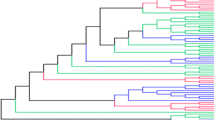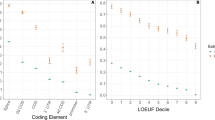Abstract
Although most codon third bases appear to be functionless, the synonymous codons so defined exhibit a strikingly nonrandom distribution (codon bias) within human and other genes. To examine this phenomenon further, we generated a database of DNA sequences encoding human transmembrane cell-surface receptor proteins. Using this database we show here that the guanine and cytosine content of codon third bases (GC3) varies intragenically with the nature of the specified receptor domains (transmembrane > extracellular > intracellular domains; p < 0.001), the phenotype of the encoded amino acids (hydrophobic > hydrophilic > neutral amino acids; p < 0.001), and the receptor affiliation of the transmembrane domain superfamily (G-protein- coupled receptors > receptor tyrosine kinases; p < 0.001). Within gene regions specifying transmembrane domains, GC3 declines as domain functionality becomes redundant with increasing hydrophobicity (p < 0.001). Codons containing the second-base cytosine (XCZ, which encodes neutral amino acids) are selectively depleted of third-base adenine content (A3: XCA codons) when encoding transmembrane domain residues, consistent with positive selection for transitional mutation of XCG to XTG (which encodes hydrophobic amino acids) rather than to the synonymous XCA. Supporting this XCG → XTG mechanism of codon bias, the G3:A3 ratio of codons specifying the transmembrane amino acid glycine (GGZ) is intermediate between that of its functional homolog alanine (GCZ) and that of hydrophobic valine (GTZ), even though the C3:T3 ratios are similar. Conversely, nearest-neighbor analysis of third bases 5′ to codons specifying valine and leucine (CTZ) confirms a significant difference in C3:T3 but not G3:A3 ratios (i.e., C3/G1 → T3/G1 > C3/A1; p < 0.001), consistent with the functionally advantageous retention of hydrophobic residues. These data raise the possibility that patterns of intragenic codon bias reflect a balance between negative and positive selection, suggesting in turn that analysis of codon third-base usage may help to predict the functional significance of encoded products.
Similar content being viewed by others
References
H Akashi (1994) ArticleTitleSynonymous codon usage in Drosophila melanogaster: Natural selection and translational accuracy. Genetics 136 927–935 Occurrence Handle1:CAS:528:DyaK2MXpsFaq Occurrence Handle8005445
JD Andrews DN Mancini SM Singh DI Rodenhiser (1996) ArticleTitleSite and sequence specific DNA methylation in the neurofibromatosis (NF1) gene includes C5839T: The site of the recurrent substitution in exon 31. Hum Mol Genet 5 503–507
SE Antonarakis M Krawczak et al. (2000) ArticleTitleDisease-causing mutations in the human genome. Eur J Pediatr 159 IssueIDSuppl 3 173–178
WJ Babidge LM Butler MA Burton PA Cowled (2001) ArticleTitleMethylation of CpG sites in exon 2 of the bcl-2 gene occurs in colorectal carcinoma. Anticancer Res 21 2809–2814 Occurrence Handle1:CAS:528:DC%2BD3MXovVyjsr0%3D Occurrence Handle11724359
MI Bellgard T Gojobori (1999) ArticleTitleSignificant differences between the G + C content of synonymous codons in orthologous genes and the genomic G + C content. Gene 238 33–37 Occurrence Handle10.1016/S0378-1119(99)00318-2 Occurrence Handle1:CAS:528:DyaK1MXntFKntbc%3D Occurrence Handle10570981
G Bernardi (1995) ArticleTitleThe human genome: Organization and evolutionary history. Ann Rev Genet 29 445–476 Occurrence Handle10.1146/annurev.ge.29.120195.002305 Occurrence Handle1:STN:280:BymH383os1I%3D Occurrence Handle8825483
BE Bernstein EL Humphrey et al. (2002) ArticleTitleMethylation of histone H3 Lys 4 in coding regions of active genes. Proc Natl Acad Sci USA 99 8695–8700 Occurrence Handle10.1073/pnas.112318199 Occurrence Handle1:CAS:528:DC%2BD38XltF2hsb8%3D Occurrence Handle12060701
RD Blake ST Hess et al. (1992) ArticleTitleThe influence of nearest neighbors on the rate and pattern of spontaneous point mutations. J Mol Evol 34 189–200 Occurrence Handle1:CAS:528:DyaK38Xhs1Okurs%3D Occurrence Handle1588594
MG Borrello MA Pierotti et al. (1992) ArticleTitleDNA methylation of coding and non-coding regions of the human H-RAS gene in normal and tumor tissues. Oncogene 7 269–275 Occurrence Handle1:STN:280:By2C1MrmsFE%3D Occurrence Handle1549348
DN Cooper M Krawczak (1989) ArticleTitleCytosine methylation and the fate of CpG dinucleotides in vertebrate genomes. Hum Genet 83 181–188 Occurrence Handle1:CAS:528:DyaL1MXmt1Ogt7s%3D Occurrence Handle2777259
PE Crossen MJ Morrison (1999) ArticleTitleMethylation status of the 3rd exon of the c-MYC oncogene in B-cell malignancies. Leuk Res 23 251–253 Occurrence Handle10.1016/S0145-2126(98)00167-2 Occurrence Handle1:CAS:528:DyaK1MXhslOmtLo%3D Occurrence Handle10071077
RJ Epstein K Lin et al. (2000) ArticleTitleA functional significance for codon third bases. Gene 245 291–298 Occurrence Handle10.1016/S0378-1119(00)00042-1 Occurrence Handle1:CAS:528:DC%2BD3cXhs12isbo%3D Occurrence Handle10717480
AJ Gillis AJ Verkerk et al. (1997) ArticleTitleMethylation similarities of two CpG sites within exon 5 of human H19 between normal tissues and testicular germ cell tumours of adolescents and adults, without correlation with allelic and total level of expression. Br J Cancer 76 725–733 Occurrence Handle1:CAS:528:DyaK2sXmsVantbw%3D Occurrence Handle9310237
X Gu WH Li (1994) ArticleTitleA model for the correlation of mutation rate with GC content and the origin of GC-rich isochores. J Mol Evol 38 468–475 Occurrence Handle1:CAS:528:DyaK2cXltVaiu7o%3D Occurrence Handle8028025
B Hendrich A Bird (1998) ArticleTitleIdentification and characterization of a family of mammalian methyl-CpG binding proteins. Mol Cell Biol 18 6538–6547 Occurrence Handle1:CAS:528:DyaK1cXmvF2nsrg%3D Occurrence Handle9774669
T Hohn S Corsten S Ricke M Muller H Rothnie (1996) ArticleTitleMethylation of coding region alone inhibits gene expression in plant protoplasts. Proc Natl Acad Sci USA 93 8334–8339 Occurrence Handle10.1073/pnas.93.16.8334 Occurrence Handle1:CAS:528:DyaK28XkvFylurk%3D Occurrence Handle8710871
LD Hurst NG Smith (1999) ArticleTitleDo essential genes evolve slowly? Curr Biol 9 747–750 Occurrence Handle10.1016/S0960-9822(99)80334-0 Occurrence Handle1:CAS:528:DyaK1MXksFGltbs%3D Occurrence Handle10421576
PL Jones GL Veenstra et al. (1998) ArticleTitleMethylated DNA and MeCP2 recruit histone deacetylase to repress transcription. Nat Genet 19 187–191 Occurrence Handle1:CAS:528:DyaK1cXls1Cqsbg%3D Occurrence Handle9620779
S Kempster WA Phillips S Baindur-Hudson RJ Thomas C Dow SP Rockman (2000) ArticleTitleMethylation of exon 2 of p16 is associated with late stage oesophageal cancer. Cancer Lett 150 57–62 Occurrence Handle10.1016/S0304-3835(99)00372-9 Occurrence Handle1:CAS:528:DC%2BD3cXhsVaiurY%3D Occurrence Handle10755387
M Krawczak DN Cooper (1996) ArticleTitleSingle base-pair substitutions in pathology and evolution: Two sides to the same coin. Hum Mutat 8 23–31 Occurrence Handle10.1002/(SICI)1098-1004(1996)8:1<23::AID-HUMU3>3.3.CO;2-H Occurrence Handle1:CAS:528:DyaK28XltVeltbc%3D Occurrence Handle8807332
C Kress H Thomassin et al. (2001) ArticleTitleLocal DNA demethylation in vertebrates: How could it be performed and targeted? FEBS Lett 494 135–140 Occurrence Handle10.1016/S0014-5793(01)02328-6 Occurrence Handle1:CAS:528:DC%2BD3MXislGqsrY%3D Occurrence Handle11311228
D Negre Y Cenatiempo et al. (1988) ArticleTitleHigh fidelity of guanine translation in a plasmid-directed in vitro system. Biochimie 70 1715–1718 Occurrence Handle10.1016/0300-9084(88)90029-6 Occurrence Handle1:CAS:528:DyaL1MXhvVOru7w%3D Occurrence Handle3150674
CT Nguyen FA Gonzales PA Jones (2001) ArticleTitleAltered chromatin structure associated with methylation-induced gene silencing in cancer cells: Correlation of accessibility, methylation, MeCP2 binding and acetylation. Nucleic Acids Res 29 4598–4606 Occurrence Handle10.1093/nar/29.22.4598 Occurrence Handle1:CAS:528:DC%2BD3MXptV2iuro%3D Occurrence Handle11713309
M Nishizawa K Nishizawa (2000) ArticleTitleAmino acid and nucleotide recurrence in aligned sequences: Synonymous substitution patterns in association with global and local base compositions. Nucleic Acids Res 28 3801–3810 Occurrence Handle10.1093/nar/28.19.3801 Occurrence Handle1:CAS:528:DC%2BD3cXntlKlsLk%3D Occurrence Handle11000273
G Okada K Ryoyama et al. (1996) ArticleTitleCarcinogen-induced de novo methylation in c-myc exon I. Jpn J Med Sci Biol 49 209–218 Occurrence Handle1:CAS:528:DyaK2sXit1yiurk%3D Occurrence Handle9095415
WM Rideout GA Coetzee et al. (1990) ArticleTitle5-Methylcytosine as an endogenous mutagen in the human LDL receptor and p53 genes. Science 249 1288–1290 Occurrence Handle1:CAS:528:DyaK3cXls1KksL0%3D Occurrence Handle1697983
PC Sabeti DE Reich et al. (2002) ArticleTitleDetecting recent positive selection in the human genome from haplotype structure. Nature 419 832–835 Occurrence Handle10.1038/nature01140 Occurrence Handle1:CAS:528:DC%2BD38XovF2itbc%3D Occurrence Handle12397357
PK Sengupta M Ehrlich BD Smith (1999) ArticleTitleA methylation- responsive MDBP/RFX site in the first exon of the collagen alpha2(I) promoter. J Biol Chem 274 36649–36655 Occurrence Handle10.1074/jbc.274.51.36649 Occurrence Handle1:CAS:528:DC%2BD3cXit1ek Occurrence Handle10593968
Z Siegfried S Eden et al. (1999) ArticleTitleDNA methylation represses transcription in vivo. Nat Genet 22 203–206 Occurrence Handle10369268
C Skerka WO Abel et al. (2000) ArticleTitleTwo human gene families display preferences for different nucleotides and have distinct codon usage patterns. Exp Clin Immunogenet 17 29–41 Occurrence Handle10.1159/000019122 Occurrence Handle1:CAS:528:DC%2BD3cXisFSltbo%3D Occurrence Handle10686481
Y Suzuki T Gojobori (1999) ArticleTitleA method for detecting positive selection at single amino acid sites. Mol Biol Evol 16 1315–1328 Occurrence Handle1:CAS:528:DyaK1MXms1Ojt70%3D Occurrence Handle10563013
NJ Tourasse WH Li (2000) ArticleTitleSelective constraints, amino acid composition, and the rate of protein evolution. Mol Biol Evol 17 656–664 Occurrence Handle1:CAS:528:DC%2BD3cXisVSgtLg%3D Occurrence Handle10742056
K Tsunoyama MI Bellgard et al. (2001) ArticleTitleIntragenic variation of synonymous substitution rates is caused by nonrandom mutations at methylated CpG. J Mol Evol 53 456–464 Occurrence Handle10.1007/s002390010235 Occurrence Handle1:CAS:528:DC%2BD3MXotVahsro%3D Occurrence Handle11675605
Acknowledgements
We thank Betty Ng for secretarial assistance.
Author information
Authors and Affiliations
Corresponding author
Rights and permissions
About this article
Cite this article
Lin, K., Tan, S., Kolatkar, P. et al. Nonrandom Intragenic Variations in Patterns of Codon Bias Implicate a Sequential Interplay Between Transitional Genetic Drift and Functional Amino Acid Selection . J Mol Evol 57, 538–545 (2003). https://doi.org/10.1007/s00239-003-2507-5
Received:
Accepted:
Issue Date:
DOI: https://doi.org/10.1007/s00239-003-2507-5




